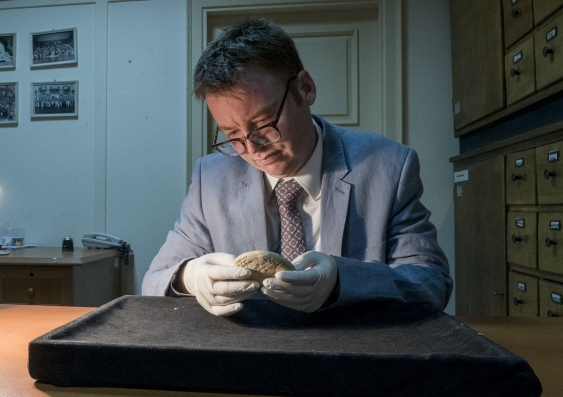Pattern and symmetry ÔÇô with a touch of surprise ÔÇô may be the mathematical formula for what we find beautiful.
Mathematics is visible everywhere in nature, even where we are not expecting it. It can help explain the way galaxies spiral, a seashell curves, patterns replicate, and rivers bend.
Even subjective emotions, like what we find beautiful, can have mathematic explanations. 
ÔÇ£Maths is not only seen as beautiful ÔÇô beauty is also mathematical,ÔÇØ says┬áDr Thomas Britz, a lecturer in ╣·▓·¥½ãÀ ScienceÔÇÖs School of Mathematics & Statistics. ÔÇ£The two are intertwined.ÔÇØ
Dr Britz works in combinatorics, a field focused on complex counting and puzzle solving. While combinatorics sits within pure mathematics, Dr Britz has always been drawn to the philosophical questions about mathematics. 
He also finds beauty in the mathematical process.
ÔÇ£From a personal point of view, maths is just really fun to do. IÔÇÖve loved it ever since I was a little kid.┬á
ÔÇ£Sometimes, the beauty and enjoyment of maths is in the concepts, or in the results, or in the explanations. Other times, itÔÇÖs the thought processes that make your mind turn in nice ways, the emotions that you get, or just working in the flow ÔÇô like getting lost in a good book.ÔÇØ
Here, Dr Britz shares some of his favourite connections between maths and beauty.
1. Symmetry ÔÇô but with a touch of surprise
In 2018, Dr Britz gave a  on the Mathematics of Emotion, where he used recent studies on maths and emotions to touch on how maths might help explain emotions, like beauty.
ÔÇ£Our brains reward us when we recognise patterns, whether this is seeing symmetry, organising parts of a whole, or puzzle-solving,ÔÇØ he says.┬á
ÔÇ£When we spot something deviating from a pattern ÔÇô when thereÔÇÖs a touch of the unexpected ÔÇô our brains reward us once again. We feel delight and excitement.ÔÇØ┬á
For example, humans perceive symmetrical faces as beautiful. However, a feature that breaks up the symmetry in a small, interesting or surprising way ÔÇô such as a beauty spot ÔÇô adds to the beauty.┬á
ÔÇ£This same idea can be seen in music,ÔÇØ says Dr Britz. ÔÇ£Patterned and ordered sounds with a touch of the unexpected can have added personality, charm and depth.ÔÇØ┬á
Many mathematical concepts exhibit a similar harmony between pattern and surprise, elegance and chaos, truth and mystery.
ÔÇ£The interwovenness of maths and beauty is itself beautiful to me,ÔÇØ says Dr Britz.
2. Fractals: infinite and ghostly
Fractals are self-referential patterns that repeat themselves, to some degree, on smaller scales. The closer you look, the more repetitions you will see ÔÇô like the fronds and leaves of a fern.┬á
ÔÇ£These repeating patterns are everywhere in nature,ÔÇØ says Dr Britz. ÔÇ£In snowflakes, river networks, flowers, trees, lightning strikes ÔÇô even in our blood vessels.ÔÇØ┬á┬á
Fractals in nature can often only replicate by several layers, but theoretic fractals can be infinite. Many computer-generated simulations have been created as models of infinite fractals. 
ÔÇ£You can keep focusing on a fractal, but you'll never get to the end of it,ÔÇØ says Dr Britz.┬á
ÔÇ£Fractals are infinitely deep. They are also infinitely ghostly.
ÔÇ£You might have a whole page full of fractals, but the total area that you've drawn is still zero, because it's just a bunch of infinite lines.ÔÇØ┬á
3. Pi: an unknowable truth
Pi (or ÔÇÿ¤ÇÔÇÖ) is a number often first learnt in high school geometry. In simplest terms, it is a number slightly more than 3.┬á
Pi is mostly used when dealing with circles, such as calculating the circumference of a circle using only its diameter. The rule is that, for any circle, the distance around the edge is roughly 3.14 times the distance across the centre of the circle.
But Pi is a lot more than this. 
ÔÇ£When you look into other aspects of nature, you will suddenly find Pi everywhere,ÔÇØ says Dr Britz. ÔÇ£Not only is it linked to every circle, but Pi sometimes pops up in formulas that have nothing to do with circles, like in probability and calculus.ÔÇØ
Despite being the most famous number (International Pi Day is held annually on 14 March, 3.14 in American dating), there is a lot of mystery around it.
ÔÇ£We know a lot about Pi, but we really don't know anything about Pi,ÔÇØ says Dr Britz.┬á
ÔÇ£ThereÔÇÖs a beauty about it ÔÇô a beautiful dichotomy or tension.ÔÇØ
Pi is infinite and, by definition, unknowable. No pattern has yet been identified in its decimal points. ItÔÇÖs understood that any combination of numbers, like your phone number or birthday, will appear in Pi somewhere (you can search this via an┬á┬áof the first 200 million digits).┬á
We currently know 50 trillion digits of Pi, a record broken earlier this year. But, as we cannot calculate the exact value of Pi, we can never completely calculate the circumference or area of a circle ÔÇô although we can get close.
ÔÇ£WhatÔÇÖs going on here?ÔÇØ says Dr Britz. ÔÇ£What is it about this strange number that somehow ties all the circles of the world together?
ÔÇ£There's some underlying truth to Pi, but we donÔÇÖt understand it. This mystique makes it all the more beautiful.ÔÇØ
4.  A golden and ancient ratio
The Golden Ratio (or ÔÇÿ¤òÔÇÖ) is perhaps the most popular mathematical theorem for beauty. ItÔÇÖs considered the most aesthetically pleasing way to proportion an object.
The ratio can be shortened, roughly, to 1.618. When presented geometrically, the ratio creates the Golden Rectangle or the Golden Spiral.  
ÔÇ£Throughout history, the ratio was treated as a benchmark for the ideal form, whether in architecture, artwork, or the human body,ÔÇØ says Dr Britz. ÔÇ£It was called the ÔÇÿDivine ProportionÔÇÖ.
ÔÇ£Many famous artworks, including those by Leonardo da Vinci, were based on this ratio.ÔÇØ
The Golden Spiral is frequently used today, especially in art, design and photography. The centre of the spiral can help artists frame image focal points in aesthetically pleasing ways. 
5. A paradox closer to magic
The unknowable nature of maths can make it seem closer to magic. 
A famous geometrical theorem called the Banach-Tarski paradox says that if you have a ball in 3D space and split it into a few specific pieces, there is a way to reassemble the parts so that you create two balls.
ÔÇ£This is already interesting, but it gets even weirder,ÔÇØ says Dr Britz.┬á
ÔÇ£When the two new balls are created, they will both be the same size as the first ball.ÔÇØ┬á
Mathematically speaking, this theorem works ÔÇô it is possible to reassemble the pieces in a way that doubles the balls.┬á
ÔÇ£You can't do this in real life,ÔÇØ says Dr Britz. ÔÇ£But you can do it mathematically.
That's sort of magic. That is magic.
Fractals, the Banach-Tarski paradox and Pi are just the surface of the mathematical concepts he finds beauty in.
ÔÇ£To experience many beautiful parts of maths, you need a lot of background knowledge,ÔÇØ says Dr Britz. ÔÇ£You need a lot of basic ÔÇô and often very boring ÔÇô training. ItÔÇÖs a bit like doing a million push ups before playing a sport.┬á
ÔÇ£But it is worth it. I hope that more people get to the fun bit of maths. There is so much more beauty to uncover.ÔÇØ
Media enquiries
Sherry Landow
News & Content Coordinator
Tel: (02) 9065 4039
Àí│¥▓╣¥▒▒¶:╠²s.landow@unsw.edu.au
Related stories
-

The history and mystery of Tangram, the children's puzzle game that harbours a mathematical paradox or two
-

Two ╣·▓·¥½ãÀ academics named 2022 Australian Academy of Science Fellows
-

Australian mathematician reveals world's oldest example of applied geometry
-

Does Amber Heard really have the worldÔÇÖs most beautiful face? An expert explains why the Golden Ratio test is bogus





